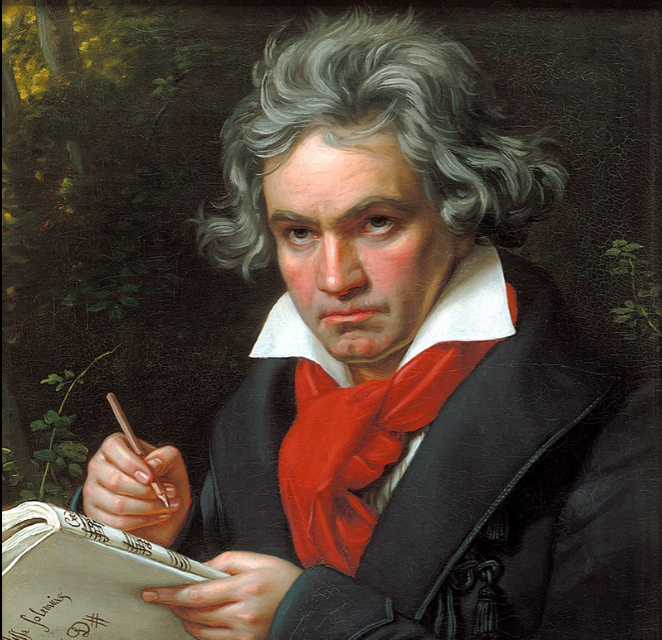Join Darien Library for a this four-week series on Beethoven by Gil Harel, a musicologist and award-winning educator who has taught at CUNY Baruch College and Naguatuck Valley Community College.
Each presentation takes place from 7 to 8 p.m. on a Wednesday in July.
— from Darien Library announcements
About the Presenter
Gil Harel (PhD, Brandeis University) is a musicologist and music theorist whose interests include styles ranging from classical repertoire to jazz and popular music, as gwell as opera, medieval, and renaissance music.
Previously, he has served on the faculty at CUNY Baruch College, where he was awarded the prestigious “Presidential Excellence Award for Distinguished Teaching”, as well as the Southwestern University of Finance and Economics in Chengdu, China.
Currently, he teaches at Naugatuck Valley Community College, where he was recently presented with the coveted “Merit Award for Exemplary Service to the College.”
At NVCC, Dr. Harel conducts the college chorale, teaches music history and theory, and serves as musical director of theater productions. Outside of teaching, he enjoys staying active as a pianist and vocalist.
About the Four Lectures
Week 1: Beethoven in the Twilight of the Enlightenment
Wednesday, July 11

Ludwig van Beethoven, a portrait by Joseph Karl Stieler, 1820
Ludwig van Beethoven was not yet 6 years old when the Declaration of Independence was signed.
This perhaps serves to remind us that the young composer grew up in an era very much dominated by Enlightenment thoughts and philosophies.
And yet, by the time he moved to Vienna to pursue his destiny in the great “City of Musicians,” society was changing rapidly.
During this program, we will discuss Beethoven’s childhood and adolescence, comparing him – as is so often the case — to W. A. Mozart.
Our repertoire discussion will cover works which reflect the logical and rational aspects of the late 18th century, as well as works which foreshadow the deeply personal and passionate attributes evinced by art of the coming era.
Week 2: The ‘Heroic’ Beethoven
Wednesday, July 18
Though his reputation had been established with early masterpieces (such as the “Sonata Pathétique”), Beethoven’s legacy was perhaps cemented when he completed his Symphony no. 3 (Sinfonia Eroica) in 1803.

An 1803 portrait by Christian Hornemann
Contemporary accounts relate that audiences were initially polarized by the work, as it presented them with a symphony whose length and scope was completely unprecedented.
Historians, connoisseurs, and casual listeners alike are often fascinated by this work for many reasons. Chief among these is the fact that Beethoven’s hearing had deteriorated considerably by the time the symphony was premiered.
The composer’s resolve to write music in the face of this relentless malady planted the seeds for the Demigod status future artists would confer upon him.
Week 3: Fate Knocking at the Door: Beethoven’s Symphony No. 5
Wednesday, July 25
Perhaps no musical motive is as iconic and instantly recognizable as that which begins Beethoven’s Symphony no. 5 in C minor.

Beethoven, a caricature from about 1825 by J.P. Lyser
Contemporary accounts suggest that this music strikes us today much as it struck listeners 200 years ago.
Audience members are often captivated by the sense of gloom and urgency which begins the work, and are taken along an odyssey which introduces lyrical determination (mvt. 2) before yielding to a demonic scherzo (mvt. 3) and finally melting into the triumphant fanfare of the finale.
The symphony constitutes an important watershed in the development of classical music, and marks what many commentators describe as a foreshadowing of the romantic style. For Beethoven, the symphony may have symbolized something deeply personal.
Week 4: Concerti, Masses, Sonatas, and the Triumph of Symphony No. 9
The last years of Ludwig van Beethoven’s life could not have been pleasant ones for the composer.

Portrait of Ludwig van Beethoven in 1823, by by Ferdinand Georg Waldmüller
Suffering from various physical maladies which in turn affected his psyche, the grizzled composer must have drawn comfort through the one act which had continued to sustain him throughout his difficulties: composing.
Among the masterpieces of this “late” period, historians and musicologists often cite the pinnacles reached in the realms of solo piano works (e.g., the op. 111 sonata), chamber music (e.g., the op. 131 string quartet), and his colossal and challenging setting of the Catholic Mass Ordinary, the Missa Solemnis.
Towering above perhaps everything else sits the famous Symphony no. 9, with a finale setting the words of Schiller’s famous “Ode to Joy” poem.
For listeners in the post-Beethoven world, this symphony has often imbued a feeling of transcendence — representing the apex of human achievement and sending out a message of hope and peace which continues to resonate today.

